List of FIFA World Cup official match balls
This is a list of the official match balls for FIFA World Cup finals tournaments.
From the 1970 FIFA World Cup, official match balls have been used by FIFA.[1]
| World Cup | Ball(s) | Image | Manufacture | Additional information | Refs |
|---|---|---|---|---|---|
| 1930 | Tiento (first half) T-model (second half) |
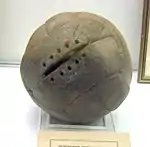  |
- | Two different balls were used in the final: Argentina supplied the first-half ball (the 'Tiento') and led 2–1 at the break; hosts Uruguay supplied the second-half ball (the 'T-Model' which was larger and heavier)[2] and won 4–2. | [2][3] |
| 1934 | Federale 102 | 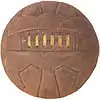 |
ECAS (Ente Centrale Approvvigionamento Sportivi), Rome |
[4] | |
| 1938 | Allen | 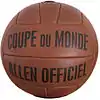 |
Allen, Paris | Made up of leather, consisted of 13 panels and had white cotton laces on a separate, thin panel. | [5] |
| 1950 | Duplo T | 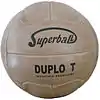 |
Superball | First ball to have no laces and introduce the syringe valve. | [6] |
| 1954 | Swiss World Champion | 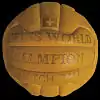 |
Kost Sport, Basel | The first 18-panel ball. | [3][7] |
| 1958 | Top Star | 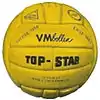 |
Sydsvenska Läder och Remfabriken, Ängelholm (aka "Remmen" or "Sydläder") |
Chosen from 102 candidates in a blind test by four FIFA officials. | [8][9] |
| 1962 | Crack | 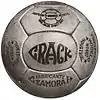 |
Senor Custodio Zamora H., San Miguel, Chile Remmen |
The Crack was the official ball. Referee Ken Aston was unimpressed with the Chilean ball provided for the opening match, and sent for a European ball, which arrived in the second half. Various matches used different balls, with the apparent rumour the European teams didn't trust the locally produced ball.[2] | [2][3][8][10] |
| 1966 | Challenge 4-Star | 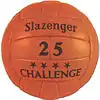 |
Slazenger | 18-panel ball in orange or yellow. Selected in a blind test at the Football Association headquarters in Soho Square. | [3][11] |
| 1970 | Telstar |  |
Adidas | Telstar was the first 32-panel black-and-white ball used in the FIFA World Cup finals. Only 20 were supplied by Adidas. A brown ball (Germany-Peru) and a white ball (first half of Italy-Germany) were used in some matches. | [3][12] |
| 1974 | Telstar Durlast | 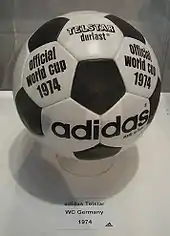 |
Adidas | The first polyurethane coated ball, making it waterproof and resistant to wear and tear. | [3] |
| 1978 | Tango | _1978_cup_Official_ball.jpg.webp) |
Adidas | The first of a family of footballs that was also used in the UEFA European Championships and the Summer Olympics until 1988. See also Adidas Tango | [3] |
| 1982 | Tango España |  |
Adidas | Similar to its predecessor the Tango the Tango España had a polyurethane coating. It had new and improved rubberized seams and was the last leather ball to be used in the World Cup. | [3] |
| 1986 | Azteca |  |
Adidas | First fully synthetic FIFA World Cup ball and first hand-sewed ball | [3] |
| 1990 | Etrusco Unico | 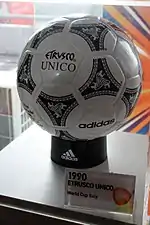 |
Adidas | [3] | |
| 1994 | Questra[13] |  |
Adidas | [3] | |
| 1998 | Tricolore | _(4170715889).jpg.webp) |
Adidas | First multi-coloured ball at a World Cup finals tournament. | [3] |
| 1999 (women) | Icon | Adidas | First ball specifically created for a Women's World Cup. Technically identical to the Tricolore, but with a different visual design. | [14][15] | |
| 2002 | Fevernova | .jpg.webp) |
Adidas | First World Cup ball with a triangular design. The ball for the 2003 Women's World Cup was technically identical to the Fevernova, but had a different visual design.[16] | [3] |
| 2006 | Teamgeist |  |
Adidas | The Teamgeist is a 14-panel ball. Each match at the World Cup finals had its own individual ball, printed with the date of the match, the stadium and the team names.[17] A special variant, the gold-coloured Teamgeist Berlin, was used in the final match. As in 2003, the ball used for the 2007 Women's World Cup was identical in performance to the ball used in the previous year's World Cup, but with a different visual design.[18] | [3] |
| Teamgeist Berlin | 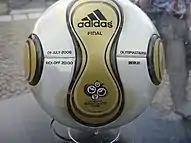 | ||||
| 2010 | Jabulani | .jpg.webp) |
Adidas | This ball has 8 panels. A special variant was used for the final match, the gold Jo'bulani (picture on the left), which was named after "Jo'burg", a standard South African nickname for Johannesburg, site of the final game. The ball was notable for the controversy it attracted, with players and fans contending that its aerodynamics were unusually unpredictable. | [3][19] |
| Jo'bulani |  | ||||
| 2011 (women) | SpeedCell | Adidas | Technically identical to the Jabulani, but with a different visual design. | [20] | |
| 2014 | Brazuca | _(cropped).jpg.webp) |
Adidas | This is the first FIFA World Cup ball named by the fans. The ball has been made of six polyurethane panels which have been thermally bonded. For the final game, a different colour scheme was used, featuring green, gold and black. | [21] |
| Brazuca Final Rio | 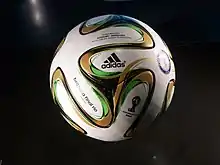 | ||||
| 2015 (women) | Conext15 | Adidas | Based on the technology introduced in the Brazuca. The Conext15 Final Vancouver is the first ball created specifically for a Women's World Cup Final. | [22] | |
| Conext15 Final Vancouver | |||||
| 2018 | Telstar 18 |  |
Adidas | For the 48 matches in the Group Stage, teams competed with a ball designed in tribute to the original Adidas Telstar, used in the 1970 and 1974 World Cups.[23] | [24] |
| Telstar Mechta | 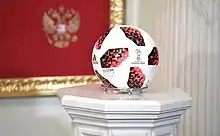 |
At the end of the 2018 World Cup group stage, FIFA revealed a new color scheme to be used for the 16 matches played in the Knockout Stage: the Telstar Mechta (Мечта). "Mechta" means dream or ambition in Russian. | [25] | ||
| 2019 (women) | Conext19 | Adidas | Used for 36 matches in the group stage. It shares the same seamless, mono-panel design as the Telstar 18, but with a glitched graphic that’s inspired by the Tricolore ball that was used in the 1998 World Cup.[26] | [27] | |
| Tricolore 19 | Inspired by the Tricolore ball and based on the same template as the Conext 19, the Tricolore 19 ball features a mono-panel aesthetic with a blue-and-red glitch graphic. This ball was used in the knockout stage. |
See also
References
- Official match balls of the FIFA World Cup™
- Classic Footballs. The Blizzard. 1 September 2012. ISBN 978-1908940063.
- "The Footballs during the FIFA World Cup". Football Facts. FIFA. Archived from the original on 28 November 2013. Retrieved 17 September 2011.
- Matteo, Renato. ""Federale 102". 1934 Italia World Cup Ball" (in Spanish). balones-oficiales.com. Archived from the original on 22 May 2013. Retrieved 17 September 2011.
- ""Allen". 1938 France World Cup Ball" (in Spanish and English). balones-oficiales.com. Archived from the original on 2 April 2012. Retrieved 17 September 2011.
- ""Super Duplo T". 1950 Brazil World Cup Official Matchball" (in Spanish and English). balones-oficiales.com. Archived from the original on 2 April 2012. Retrieved 17 September 2011.
- "1954 Switzerland World Cup Official Matchball" (in Spanish and English). balones-oficiales.com. Archived from the original on 19 August 2011. Retrieved 17 September 2011.
- Norlin, Arne (2008). "Bollen "Made in Sweden"". 1958: När Folkhemmet Fick Fotbolls-VM (in Swedish). Malmo: Ross & Tegner. pp. 130–6. ISBN 978-91-976144-8-1.
- "Top Star 1958" (in Spanish and English). balones-oficiales.com. Archived from the original on 2 April 2012. Retrieved 17 September 2011.
- Matteo, Renato (11 June 2010). ""Crack". 1962 Chile World Cup Official Matchball". balones-oficiales.com. Archived from the original on 2 April 2012. Retrieved 17 September 2011.
- Matteo, Renato (11 June 2010). ""Slazenger Challenge 4-star". 1966 England World Cup Official Matchball". balones-oficiales.com. Archived from the original on 2 December 2013. Retrieved 17 September 2011.
- Brown balls are visible in Getty Images photos of matches in the Estadio Nou Camp, León, Guanajuato:
- football World – Adidas Questra (Accessed 9 June 2006)
- "Adidas Equipment Icon". SoccerBallWorld.com. Retrieved 29 December 2016.
- "69 days to go" (Press release). FIFA. 29 March 2015. Retrieved 8 June 2015.
- "Official World Cup Fevernova Soccer Ball". SoccerBallWorld.com. Retrieved 29 December 2016.
- football World – Team Geist (Accessed 9 June 2006)
- "The History of the Official World Cup Match Balls". SoccerBallWorld.com. 29 December 2016.
- "The adidas JO'BULANI – Official Match Ball for the final of the 2010 FIFA World Cup in South Africa". FIFA. Retrieved 17 September 2011.
- "Official Women's World Cup Match Ball: SpeedCell". SoccerBallWorld.com. Retrieved 29 December 2016.
- "adidas Brazuca – Name of Official Match Ball decided by Brazilian fans". FIFA. Retrieved 2012-09-03.
- "adidas unveils Official Match Ball for the Final of the FIFA Women's World Cup 2015" (Press release). FIFA. 7 June 2015. Retrieved 8 June 2015.
- Liao, George (June 21, 2018). "Ball loses air in four incidents since World Cup kicked off". Taiwan News. Retrieved June 24, 2018.
- "2018 FIFA World Cup™ official match ball unveiled: an exciting re-imagining" (Press release). FIFA. 9 November 2017. Retrieved 9 November 2017.
- "adidas Football Reveals Official Match Ball for the Knockout Stage of the 2018 FIFA World Cup Russia™". 2018 FIFA World Cup™. 2018-06-26. Retrieved 2018-07-01.
- "adidas Launch The 2019 Women's World Cup Ball". SoccerBible. Retrieved 2019-11-09.
- FIFA.com. "FIFA Women's World Cup 2019™ - News - Official ball for France 2019 Knockout phase unveiled - FIFA.com". www.fifa.com. Retrieved 2019-11-09.
External links
This article is issued from Wikipedia. The text is licensed under Creative Commons - Attribution - Sharealike. Additional terms may apply for the media files.